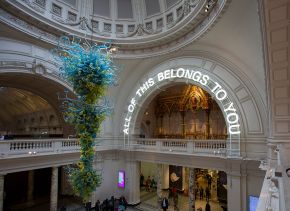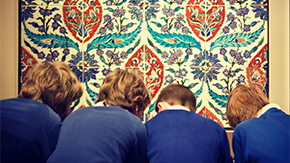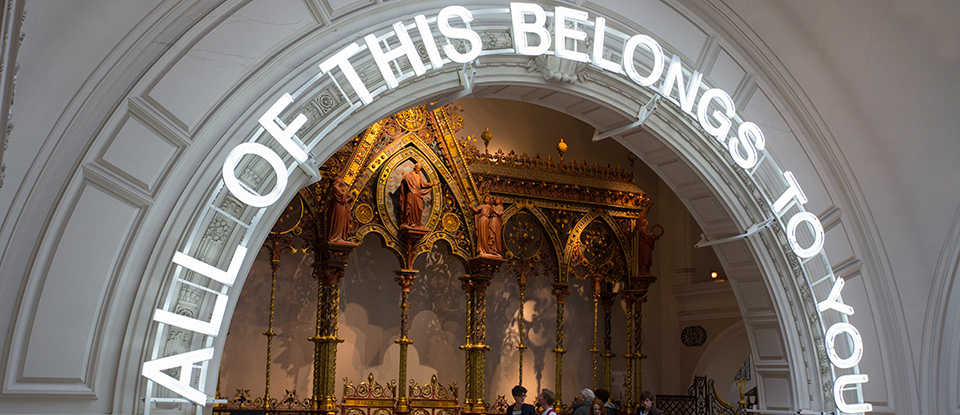Closed Exhibition - All of This Belongs to You
About the Installations

'All of This Belongs to You' Neon Invitation by Neon Circus 2015
Four major site specific installations were commissioned specially for All of This Belongs to You.
Download the guide map here.

'The Ethics of Dust' Installation by Jorge Oter-Palios, 2015
Jorge Otero-Pailos
New York-based artist and architectural preservationist Jorge Otero-Pailos’s installation The Ethics of Dust: Trajan’s Column interacts with the largest object in the Museum. Using conservation latex, Otero-Pailos cleaned the hollow inside of the cast of Trajan’s Column, removing dust and dirt accumulated over decades in this usually unseen space. The result is giant latex ‘cast of a cast’ that is exhibited adjacent to the original, revealing the passage of time, and highlighting the Museum’s duty of care to the public collection.
For more information about Jorge’s work click here www.oteropailos.com/

More than one (fragile) thing at a time by muf architecture, 2015
muf architecture/art
London-based practice muf architecture’s project titled More than one (fragile) thing at a time takes place within the Medieval and Renaissance galleries. This area of the Museum was originally designed as an archetypal public space, with daylight, sculptures of standing figures, and a fountain. muf’s installation will host a series of activities, all provoked by the existing contents of the gallery and the afterlife of the places those objects came from.
For more information on their work click here www.muf.co.uk/

Phenological Clock by Natalie Jeremijenko, 2015
Natalie Jeremijenko
Natalie Jeremijenko is an engineer, educator and ecologist, her work explores the larger natural contexts we exist within - from atmospheres to animals. Natalie’s created three related pieces under the title Re Public of Air, each considering the Museum within the wider ecology of the city. A Phenological Clock in the grand entrance will depict 12 months in the life-cycle of the flowering plants and pollinating insects that surround the V&A, Ag Bags on the low walls at the front of the museum will introduce plant life to the stone architecture, and a Moth Cinema will create a habitat for insects, celebrating their critical role in our daily lives.
For more information about her work click here www.nataliejeremijenko.com/

Five Eyes by James Bridle, 2015
James Bridle
James Bridle’s installation Five Eyes takes its name from the alliance of major global intelligence powers. Using an algorithm of the sort employed by these agencies, objects have been automatically selected from an analysis of the Museum collection’s 1.4 million digital records. The resulting displays incorporate the Museum's archive files to create networks of objects that reveal the history and present state of surveillance and state power.
For more information on his work click here
International Training Course

The Victoria and Albert Museum welcomes applications for ‘Creating Innovative Learning Programmes’, its new one week intensive course. This is a unique training opportunity for museum professionals from overseas who are interested in attracting and programming for a range of museum audiences.
Find out more